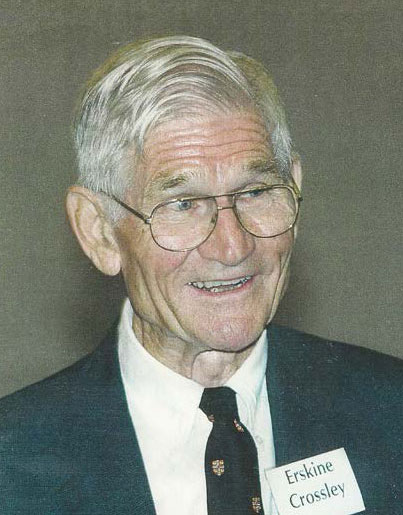
Francis Rendel Erskine Crossley
We thank the authors for sharing these precious memories and historic insights for the whole IFToMM community.
Professor Francis Rendel Erskine Crossley
I. Professor Crossly
Francis Rendel Erskine Crossley was born on 21 July 1915, in Belper, Derbyshire, England. His father Erskine Alick Crossley was director of Crossley Motors Limited, and his mother Edith Mary Helme came from a political family from Lancaster. Erskine passed away on February 4th, 2017; He is shown in the year 1929 in England and in the year 2010 in USA in Figs. 1 and 2 respectively.
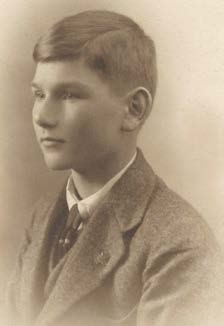
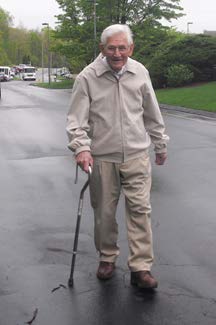
II. Education in England
Erskine went to preparatory school in Amesbury, Surrey and worked on electrical engines run on batteries. At an early age of 12, he wrote a letter to his parents “I have just had an idea and mapped it out. It is an electric engine run by five batteries, it also has a cog in the centre of the rails to climb hills, a reverse gear and a fast and a slow gear. It can’t have both cog and driving wheel in gear at the same time.”
In 1928, he went to Britain’s leading independent schools for boys, Harrow School in London. This is the same school where Sir Winston Churchill studied. Erskine recalls the ritual that the school required each morning. “Imagine a big bare room, with a row of shower stalls along one side, and a row of six bathtubs side by side, all filled to overflowing with cold
water, the taps running continuously. Then about thirty young fellows, all quite naked, first enjoyed the steaming hot showers, and then required to plunge into one of the cold baths. Each bath was already filled to the brim, so when you jumped in, you sent a huge wave plunging out over the head of the bath onto the floor. You only stayed in a few seconds, jumped out, and ran for your warm towel.” Erskine went to Clare College, Cambridge University in 1933. Here, he joined the university boat club. He was a member of the Clare College Eight that won the Ladies Plate at the Henley Royal Regatta in 1937. He hung proudly the three oars for many years in his Connecticut home. They carried the names of each member of the 1934-1936 crew teams to commemorate the triumphs over Oxford University in the three annual boat races on the River Thames. Erskine graduated with a B.A. degree in the year 1937 from Cambridge.
III. England to US
After graduation in September 1937, he moved to Detroit in US. There he met Mary (May) Elanore Coyne, while attending services in Central Methodist Church and got married on August 23, 1941. After working for some time as a mechanical engineer at General Motors Corporation, he began teaching at the University of Detroit and in 1943 moved to Yale. There he taught a course in kinematics, the first of a standard sequence of courses in Machine Design. He followed the books of G. L. Guillet; Elements of Mechanism by P. Schwamb, A.L. Merrill, and W.H. James; Mechanism, by R.M. Keown and V.M. Faires; and Mechanics of Machinery, by C.W. Ham and B.J. Crane. He also used manuals, Problems in Kinematics, by L.M. Headley; Mechanism Problems, by A.S. Hall, Jr., and E.W. Azpell; and Kinematic Problems, by R.M. Wingren. Besides he also taught evening courses at the New Haven Junior College at this time. It can be easily surmised that the basic foundations of his love for the subject of Kinematics and Dynamics leading to Design was laid during this period. This love of Kinematics and Dynamics led to his starting research in 1945 in mechanical engineering at Yale University resulting in Doctor of Engineering degree for his thesis Analysis of wide-angle motion of the pendulum torsional vibration absorber in 1949. All this time, his wife May looked after their two children: Phyllis deLacy Crossley Mervine, and Michael Francis Erskine Crossley. At Yale University, Erskine held several teaching and research appointments: 1944 – 1948, Visiting Lecturer, 1948 – 1949, Lecturer, 1949 – 1955, Assistant Professor, 1955 – 1963, Associate Professor, 1963 – 1965. From 1948 – 1965, he served as a Yale residential college fellow for Branford College. The digital computer appeared during II World War and in the early 1950s, together with the analog computer they were applied to motion simulation of linkages, thereby partially replacing the traditional graphical methods. In 1957 German kinematicians Rudolf Beyer, Kurt Hain and Walther Fritz Heinrich Meyer zur Capellen gave lectures on their research in the USA. These lectures influenced Crossley, who, according to Georgia Tech Alumni Magazine, in 1965 began (at Yale) work on “Synthesis of Mechanisms” using analog computers. From his lectures at Yale University, he wrote the pioneering book Dynamics in Machines, in 1954 published by Ronald Press Company, New York. With “Synthesis of Four Bar Linkages Using Complex Numbers,” by George N. Sandor in 1959, new aspects of kinematic synthesis by digital computers came into practice. Sandor joined Erskine on the faculty at Yale as an Associate Professor in 1962. Professor Crossley was known to be one of the best teachers of Dynamics and Controls and Nonlinearities. As an expression of his love of teaching this subject, he organized an International conference titled The First International Conference for Teachers of Mechanisms, sponsored by the National Science Foundation, on 27-30 March 1961 at Yale University. This was attended by eminent professors and researchers from western countries; Kurt Hain, Meyer zur Capellan, Walther Fritz Heinrich, Joseph Beggs, Ferdinand Freudenstein, Sigmund Rappaport, Artur Rothbart, Oene Bottema, Jaques Denavit, Sol Hasson, Bernard W. Shaffer, Irvin Krause, M.D. Cooper, Kenneth Hunt amongst others. Erskine himself presented a paper in this conference titled Dynamic mechanisms and nonlinear control systems. The proceedings were edited by him and published by the Shoe String Press in Hamden, CT. Erskine attended Kurt Hain’s course of lectures on “Number Synthesis” and taught the subject himself. Erskine frequently had discussions on ten-bar linkages with a Yale professor of Mathematics, Dr. Oystein Ore, a specialist in graph theory. Upon Ore’s suggestion Erskine tried inverting the linkage and it led to him proving how many planar ten-bar linkages exist. He presented this work at a Conference on Theoretical and Applied Mechanics in Atlanta, Georgia, in 1964. In 1962-1963, Erskine was awarded a Fulbright lectureship to the Technological University of Munich, Germany, and his first article on the simulation of the four-bar linkage was published there in 1963. This analog computer development was the basis of one of the courses offered at a four week workshop for university professors, in July 1963 at Yale, titled: Advanced Science Seminar in Mechanisms. As a byproduct of Erskine’s organizing the Yale summer school his first conceptions for the creation of the Journal of Mechanisms evolved. In the summer of 1964, Erskine was invited again to Germany to lecture at five different universities. There he worked on the four-bar linkage and its coupler curves, and also did some work on the slider-crank inversions and function generation curves. Then in the fall of 1964, Erskine was invited by Professor Bill Johnson to teach a graduate course on mechanisms in the School of Mechanical Engineering at the Manchester Institute of Science and Technology, England. Professor Johnson was the editor of the International Journal of Mechanical Sciences, published by Pergamon Press; and he introduced Erskine to Sir Robert Maxwell, chairman of this publishing house, and so the Journal of Mechanisms was born. He lectured widely in his native England: Manchester, Swansea, Salford, Sheffield and Cambridge, and also at several schools in Germany and Italy. This was a golden era of kinematics with several significant contributions from Dudley, Freudenstein, Erdman and Sandor, Faires, Green, Hall, Ham, Crane, and Rogers, Holowenko, Reuleaux and Rosenauer and Willis amongst others. Fig. 3 shows Professor Crossley presenting a seminar on Nonlinearities in 1965.
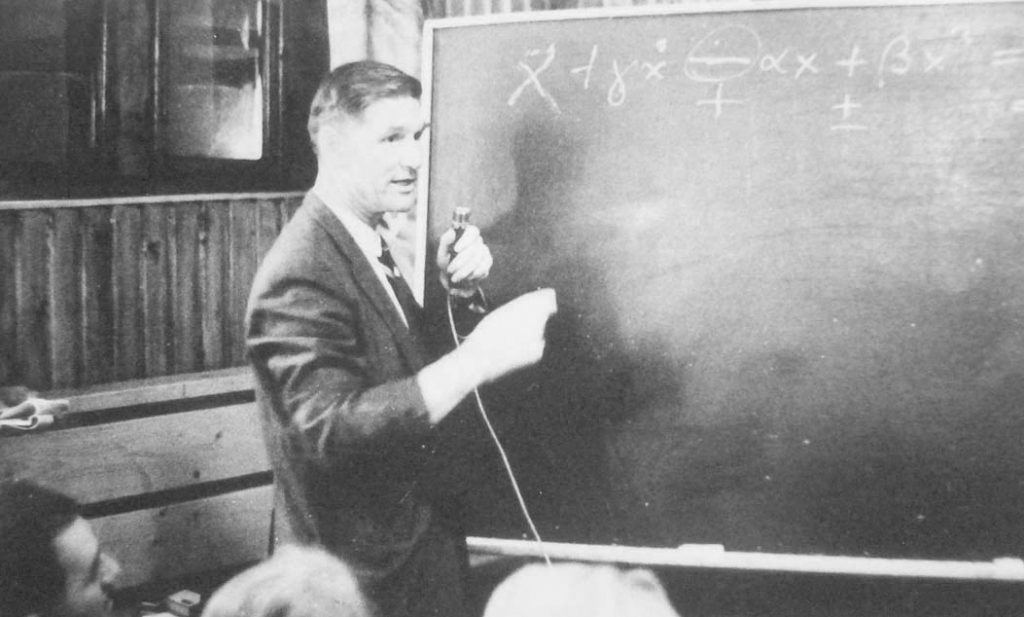
In 1965, Erskine moved to the Georgia Institute of Technology, Atlanta, GA, as a Professor in the School of Mechanical Engineering. As a pioneer in using digital computers for “Mechanism Structural Analysis and Type Synthesis” in mechanical design, he assembled a lively group of faculty and students in 1967, conducted weekly research seminars, that included students and faculty from other departments and even from other universities e.g., University of Florida. Though he enjoyed life in Georgia, May ultimately wanted to return to her beloved home on the Connecticut shore.
IV.Formation of IFToMM
Theodore von Kármán, Professor in Aachen (Germany) proposed in 1922 the need for scientific congresses which were rare when the world was recovering from the ravages of World War I and some thirty people, all Europeans, met in Innsbruck to talk and listen. In that way the International Union for Theoretical and Applied Mechanics (IUTAM) came into existence then. However, the formal constitution of IUTAM was adopted only on 26th of September 1946 just after the II World War. In contrast, it was the wisdom of Professors Artobolevskii and Crossley who had foreseen the difficulties of Cold War problems, planned well and came together to form the International Federation of Theory of Mechanisms and Machines (IFToMM) in just two years’ time. A fundamental subject in Mechanical Engineering is the Theory of Mechanisms and Machines and it was the desire of many mechanical engineers to have an International Union in this subject and bring scientists to a common platform for intense discussions. The first International Conference on Mechanisms and Machines was held at the Drouzhba resort near the city of Varna, Bulgaria, from 27-30 September 1965. The participants came from 17 countries (including England, Australia, West Germany, East Germany, and other East European countries). None from the USA attended this conference. A total of 54 papers were presented at the conference. The initiative for the conference came from the Scientific and Technical Union and the Mechanical Engineering and Electro-technical Institute in Sofia, Bulgaria. Here, outstanding specialists and scientists in the field of Mechanisms and Machines discussed the pressing need for holding international meetings. An International Coordinating Committee was set up with objectives to plan future international conferences and to study, and possibly prepare the way for, the establishment of an International Federation on Mechanisms and Machines. In October 1967, Professor Artobolevskii organized a Mechanisms seminar at Sukhumi, Soviet Georgia and invited Professors Crossley, Meyer zur Capellen, Sandor and den Hartog. Professor Crossley reciprocated with an invitation for ASME conference on Mechanisms in 1968. In this meeting Professor Artobolevskii proposed that a worldwide federation for the subject of TMM be formed which received enthusiastic response from the Western team of Professors. This resulted in the meeting at Varna, Bulgaria, held on July 24, 1969, where delegates from other countries had been added. India was one of them. This was followed by a historic meeting in Zakopane. IFToMM was founded as the International Federation for the Theory of Mechanisms and Machines in Zakopane, Poland on September 29, 1969 during the Second World Congress on TMM. Professor Jan Oderfeld Chairman of Polish Committee opened the meeting as in Fig. 4. Professor Len Maunder from England and Professor J S Rao from India, founding fathers present today are identified in this figure. Professor Crossley addressed this meeting as given in Fig. 5.
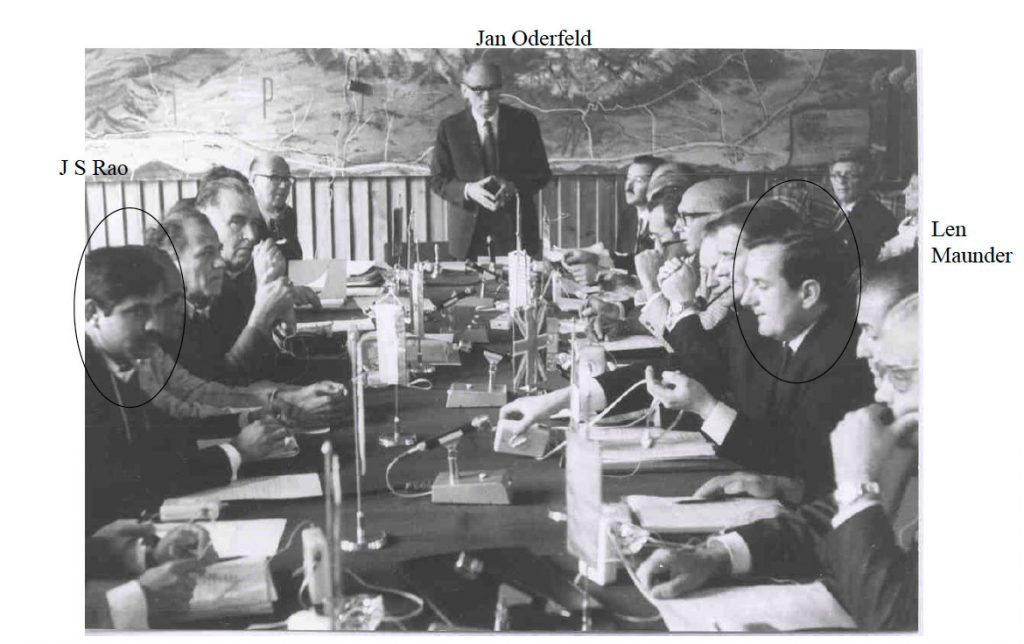
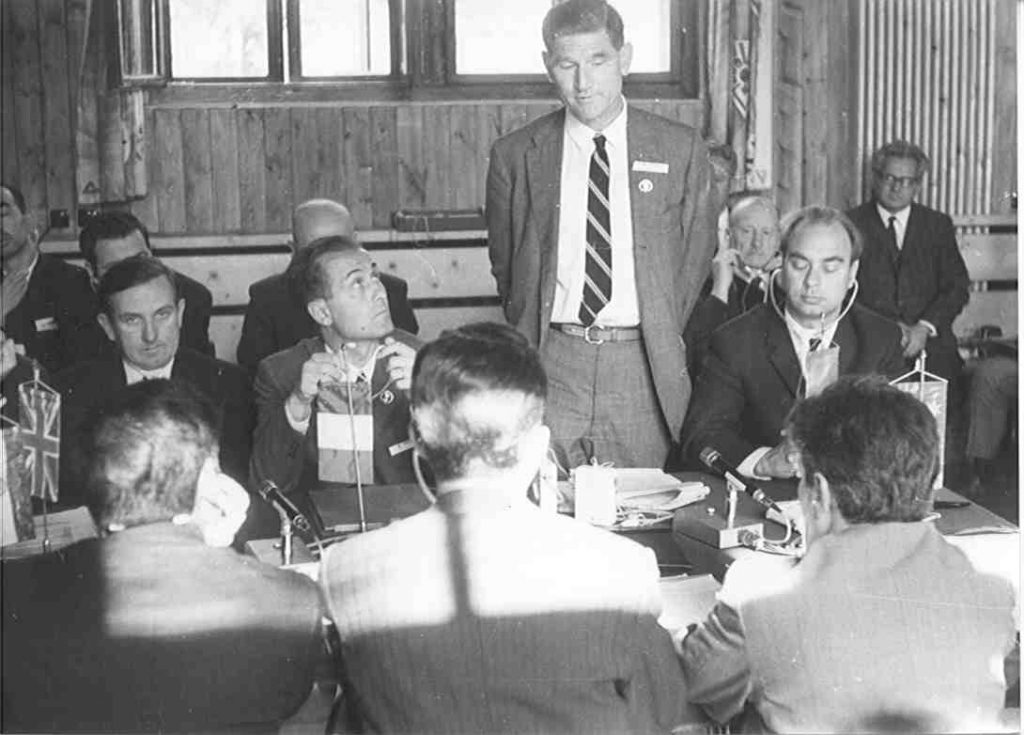
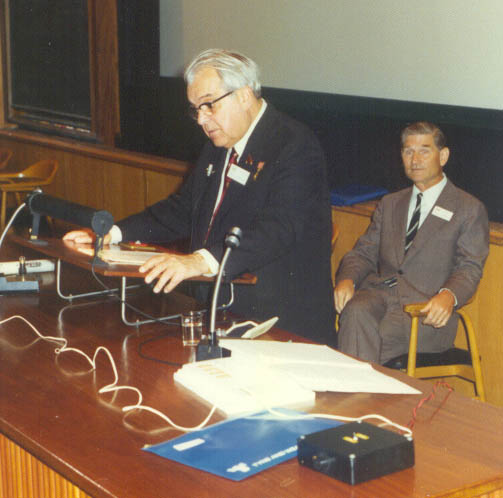
On this historic day, Professor Artobolevskii and Professor Crossley became the founding President and Vice President as shown in Fig. 6. IFToMM started as a family of TMM scientists among whom we may identify the IFToMM founding fathers, who signed or contributed to the foundation act with the initial 13 member organizations. Fig. 7 shows these signatories. At the inaugural congress, President Artobolevskii introduced a song that he had written called “Hymn to IFToMM” the words are:
Hard have we worked at TMM
The importance of it being clear
Many men have given their talent
To this science so very dear!
We decided to work together
And to do this well
We founded a new IFToMM body
And thus we shall further dwell!
Chorus
IFToMM chaps, let’s drink
And will you be merry and happy
Ask to fill your glass up to the brink
Eat, drink and be merry!
We became very dear to each other
Having solved all the difficult tasks
Now let’s fill our glasses and hope
That our IFToMM for ever lasts!
With golden wine we’ll fill our glasses
And sign new IFToMM’s rhymes
Let’s never break our friendship
In coming future times.
Repeat the Chorus
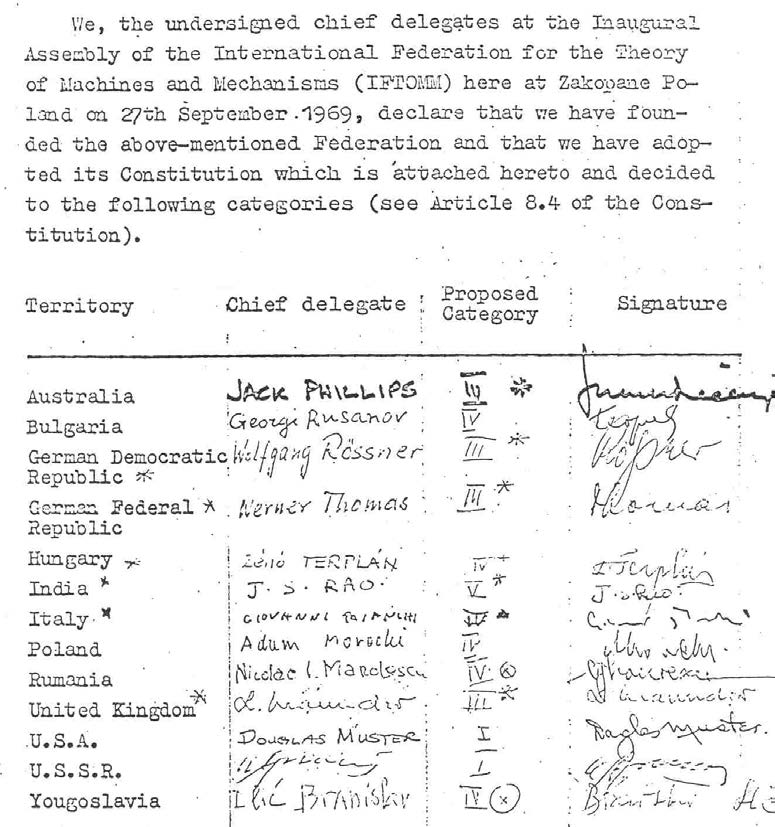
IFToMM thus established grew to strength of 48 members and made several significant contributions over 48 years for the promotion of Mechanism and Machine Science in the World. A general assembly was established with an approved constitution (that has been slightly updated along the years). The first Executive Council was elected by recognizing the role of main promoters with Prof. Artobolevskii (USSR) as president, Prof. Crossley (USA) as vice-president, Prof. Konstantinov (Bulgaria) as secretary general, Prof. Thomas (Germany) as treasurer, and Prof. Belgaumkar (India), Prof. Hunt (Australia) and Prof. Oderfeld (Poland) as members. IFToMM was structured as centered in international activity with conference organization and four commissions Commission A for Standards with Prof. Muster as Chair, Commission B for Education with Prof. Konstantinov as Chair, Commission C for Collaboration with Industry with Prof. Teodor Pantelic as Chair, and Commission D for Conferences with Prof. Crossley as Chair. Just after, in 1970 one more commission was started as the Commission for Publications with Prof. Crossley as Chair and then in 1973 the Commission for History was established with Prof. Phillips as Chair.
V. IFToMM since 1969
Erskine recalled that the Third Congress in 1971, held at Kupari, Yugoslavia, was a huge success and a wonderful occasion for him. Professor Pantelic was chairman and organizer and Professor Trbojevic was chairman of the papers committee (198 papers were presented and published in 8 volumes). Professor Crossley was the first American mechanical engineer to be elected an honorary member of the Yugoslav National Council for Engineering. In 1973, he attended a luncheon in Belgrade to celebrate the occasion. He then visited Warsaw where he made contacts on behalf of the National Science foundation to help build new research programs in Poland. In 1972, the Journal of Mechanisms became the official voice of IFToMM and was renamed Mechanism and Machine Theory. The change of name occurred in Volume 7, Issue 1, which also contained the first issue of the IFToMM news sheet. Erskine served as the Editor until the spring of 1973 with Professor Uicker as Editor-in-Chief. Erskine himself became the Executive Editor. Professor Crossley became Editor Emeritus in 1983.
The Fourth IFToMM Congress was held in Newcastle-upon-Tyne, England, from 8-13 September 1975. Erskine noted that 230 papers were published, written by authors from 25 different countries. We were growing! At this conference a new executive council was elected with Professor L. Maunder as President and Professor C. Pelecudi the Vice-President.
Professor Crossley had served as Vice-President from its founding in 1969 until 1975 and was made an Honorary Member of IFToMM. Here Professor Crossley is seen with Professors Artobolevskii, Parszewski, and Bessonov in Fig. 8.
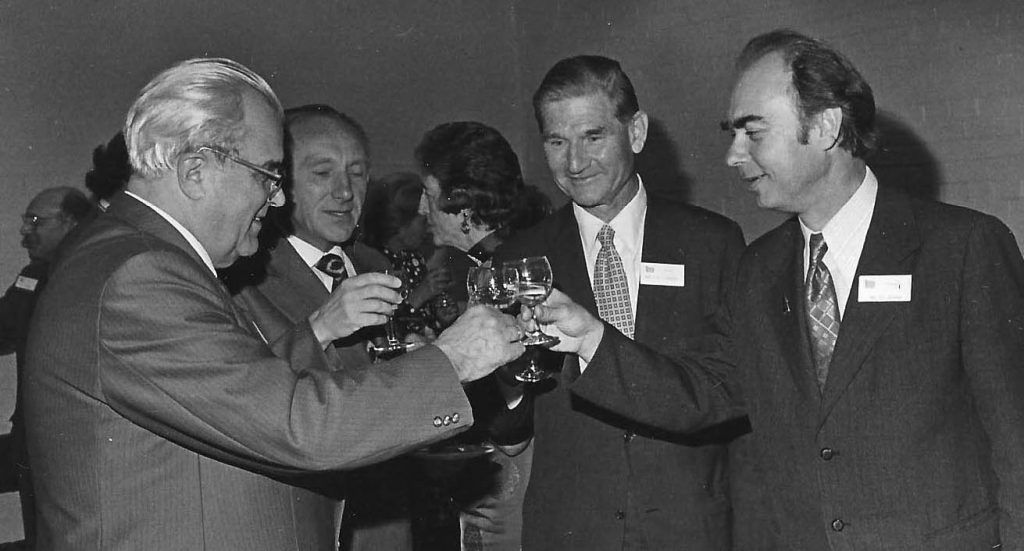
Although May was not formally titled, she continued to be of invaluable help to IFToMM journal in offering advice on international relations to Professor Uicker. Erskine and May kept up their voluminous correspondence to many colleagues at home and abroad. She is seen in Fig. 9 with colleagues Professors Konstantinov, Luck, Morecki and Uicker in New Castle upon Tyne in 1975.
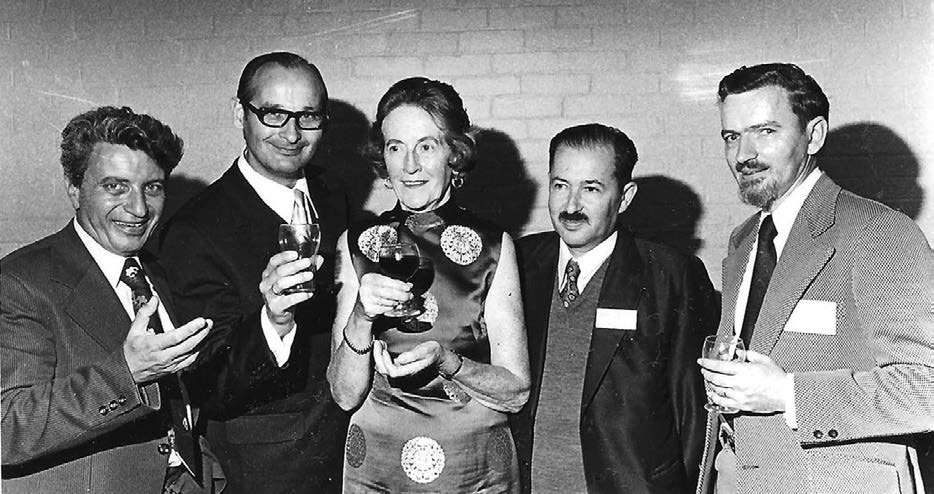
Professor Crossley and May revisited Warsaw in 1975 and spent two months working at the Polytechnic under a new international program for American–Polish joint scientific research with Dr. Andrzej Oledzki of the department of the theory of machines and mechanisms. The Fifth World Congress on the Theory of Machines and Mechanisms was held at Montreal, Canada, July 8-13, 1979. Here the research work done by Erskine in Warsaw under American-Polish joint program was presented and published as two papers On the Modeling of Impacts of Two Elastic Bodies having Flat and Cylindrical Surfaces with Application to Cam Mechanisms, and Computer Modeling of Systems with Intermittent Motion. Erskine continued as Professor of Mechanical Engineering at the University of Massachusetts, Amherst, until 1983. He then was appointed Professor Emeritus of Civil and Environmental Engineering. Professor Crossley was awarded the rank of Life Fellow of the ASME. After retirement, Erskine and May moved back to their beloved home in Connecticut and served in the Connecticut State Legislature.
Professor Crossley was among those who chose New Delhi, India as the venue for IFToMM’s 1983 World Congress. Here 35 countries participated with 338 papers presented. Professor Crossley with his retirement and moving to Connecticut did not attend much to the delegates’ disappointment. In all 14 IFToMM world congresses were held so far. As can been seen in Table 1 Erskine’s passion as a founder helped to create an enduring international forum for the worldwide mechanisms and machine community.
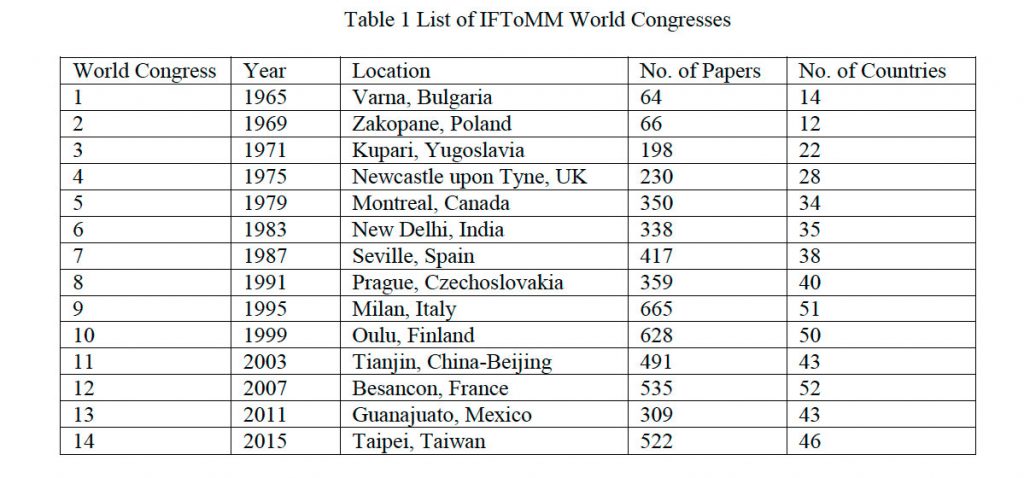
Professor Crossley attended the 8th World congress in 1991 in Prague as given in Fig. 10.
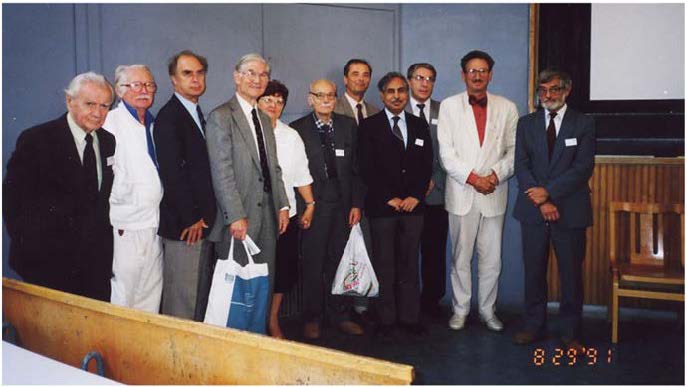
Fig. 10 Executive Council members during the 1991World Congress in Prague (from left to right) Prof. Nicolae Manolescu, Prof. Jack Phillips, Prof. Arkady Bessonov, Prof. Erskine F.R. Crossley, Prof. Elizabeth Filemon, Prof. Jan Oderfeld, Prof. Gunther Kunad, Prof. Jammi S. Rao, Prof. H. Dresig, Prof. J. Volmer, and Prof. Adam Oledkci.
In 1988 at age 73, Erskine wrote a fascinating article, Recollections from Forty Years of Teaching Mechanisms, that appeared in the ASME Journal of Mechanisms, Transmissions, and Automation in Design, Vol. 110, No. 3, pages 232-242, September 1988. The following is a brief extract from the article to illustrate his humility: It has been for me a real privilege to have known and worked with Doug Adams, Joe Beggs, Ferdinand Freudenstein, Tom Goodman, Al Hall, Dick Hartenberg, “Yappie” J.P. Den Hartog, Herb Kuenzel, Jack Kimbrell, Jerry Lowen, Chuck McLarnan, Nicholas Rosenauer, George Sandor, Joe Shigley, Merhyle Spotts, Deh Tao, Del Tesar, and others in Europe, Japan, and Australia, as well as many younger men. Some of these are no longer living, but I thank them all for having been such a blessing. Many of them have surpassed me in the high quality of their technical contributions, while I have tried to work on organizations and journals.
May passed away on May 1, 1998 after a long illness. Within a year, living alone at the home where they had raised their family became intolerable for Erskine. So he sold the house and moved to Evergreen Woods, a retirement community in North Branford, CT, where many of his old friends had also moved. Within days he met Virginia Ginny Galpin, a widow who was on the Welcoming Committee. She was about to leave for a trip around Asia, but she was clearly struck by this youthful octogenarian. When she returned they caused much excitement at Evergreen by quickly becoming a couple. They decided to marry to put a stop to the gossip, and, according to Erskine, “At our age, you can’t afford to wait
around.” On 31 August 1999, Erskine and Ginny were married at the Trinity Church in Branford, CT. They enjoyed 14 years together before Ginny died on 8 September 2013. In spite of their advanced age, Ginny – who was just a few years younger – had told a relative that “living with Erskine is heavenly.” In recognition of Crossley’s 100th birthday a special issues of the journal he founded was dedicated to him: Mechanism and Machine Theory, Vol. 89 (2015) In addition a special session on Crossley was held at the 14th IFToMM World Congress in Taipei on October 26 2015. The Session Chairs were Prof. Marco Ceccarelli, University of Cassino and South Latium, Italy and Prof. John J. Uicker, University of Wisconsin, USA. There were six papers presented, 1. The Life and Work of Erskine Crossley – The First Vice-President of IFToMM by Gordon R. Pennock from Purdue University, USA and John J. Uicker from University of Wisconsin, USA; 2. Theory of Machines through 20th Century by J. S. Rao, Kumaraguru College of Technology, India; 3. An Algorithm for the Automatic Sketching of Generalized Kinematic Chains, by Y. T. Chiu, Taiwan Semiconductor Manufacturing Company, Taiwan and H. S. Yan, National Cheng Kung University, Taiwan; 4. Professional Interactions with Professor Erskine Crossley by Kenneth J. Waldron, University of Technology Sydney, Australia and Daniel A. Jacob, University of Michigan School of Kinesiology, USA; 5. Pose Estimation Using Redundant Measurements and Polar-Decomposition Filtering, by Xiao He, Jorge Angeles and Jozsef Kövecses, McGill University, Canada and 6. On How Compliant Feet Support Postural Stability in Two Legged Locomotion, by T. Zieli ska, Warsaw University of Technology, Poland. His photograph in his 80th year (circa 1995) is shown in Fig. 11.
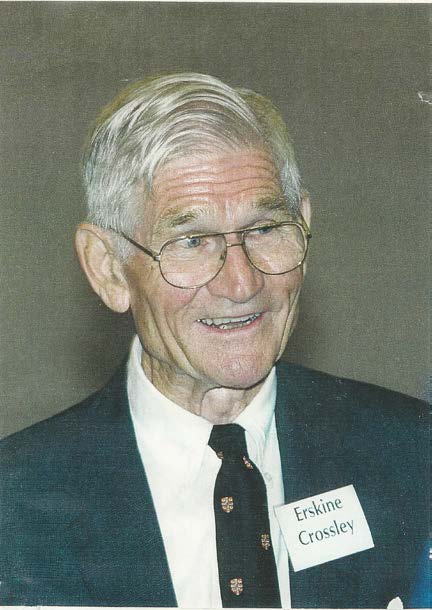
Erskine passed away on February 4th, 2017. He is no more with us to guide the Mechanisms and Machines community. We have to carry on with the spirit of international community and good will that he so wisely created.
Acknowledgment We are thankful to all the IFToMMicians in giving us the opportunity to write this obituary article on a great visionary Professor Francis Rendel Erskine Crossley.
 Find your
Find your